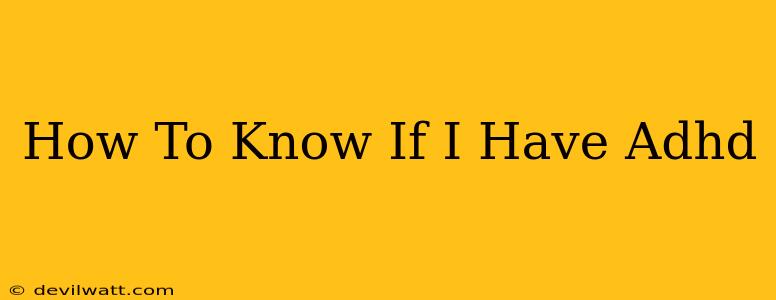Attention-Deficit/Hyperactivity Disorder (ADHD) is a neurodevelopmental disorder that affects millions worldwide. It's characterized by inattention, hyperactivity, and impulsivity. However, recognizing ADHD in yourself can be challenging, as symptoms vary greatly from person to person and can overlap with other conditions. This guide will help you understand the key signs and symptoms of ADHD and navigate the process of seeking a diagnosis.
Understanding ADHD Symptoms: The Trifecta of Challenges
ADHD isn't just about being "hyper" or "scatterbrained." It's a complex condition impacting various aspects of life. The core symptoms are typically grouped into three categories:
1. Inattention: Difficulty Focusing and Staying on Task
Individuals with ADHD often struggle with:
- Sustained Attention: Finding it hard to concentrate on tasks, even those they find interesting. Their minds may wander frequently.
- Organization and Planning: Difficulty prioritizing tasks, managing time effectively, and following instructions. They might struggle to keep their belongings organized.
- Forgetfulness: Frequently misplacing items, forgetting appointments, or neglecting responsibilities. This can extend to everyday tasks.
- Easily Distracted: Their attention is easily drawn away by external stimuli, making it challenging to focus on the task at hand.
2. Hyperactivity: Excessive Movement and Restlessness
Hyperactivity manifests differently in adults versus children. Common signs include:
- Fidgeting and Squirming: Constant restlessness, even when sitting still is expected.
- Excessive Talking: Interrupting conversations frequently and talking excessively, even when it's inappropriate.
- Difficulty Sitting Still: Feeling a strong urge to be constantly moving, pacing, or tapping their feet.
- Restlessness and Impatience: Struggling to remain calm and patient, especially when waiting or facing delays.
3. Impulsivity: Acting Without Thinking and Difficulty With Self-Control
Impulsivity involves acting on urges without considering the consequences. This can lead to:
- Blurting Out Answers: Interrupting conversations or responding impulsively without thinking.
- Difficulty Waiting Their Turn: Struggling to patiently wait for their turn in line or in conversations.
- Making Risky Decisions: Engaging in behaviors that have potentially negative consequences without considering the risks involved.
- Emotional Impulsivity: Reacting emotionally and intensely to situations without proper consideration.
Beyond the Core Symptoms: Recognizing Other Indicators of ADHD
While the core symptoms are crucial, other indicators might point towards an ADHD diagnosis. These include:
- Low Frustration Tolerance: Easily becoming frustrated or angered when facing challenges or setbacks.
- Problems with Time Management: Constantly running late or struggling to meet deadlines.
- Emotional Dysregulation: Experiencing significant mood swings or difficulties managing emotions.
- Difficulties with Relationships: Experiencing strained relationships due to impulsivity, inattention, or hyperactivity.
- Low Self-Esteem: Struggling with self-worth due to frequent failures or perceived inadequacies.
Seeking a Professional Diagnosis: The Crucial Next Step
It's important to remember that self-diagnosing is not sufficient. While this guide helps you understand potential symptoms, only a qualified healthcare professional can accurately diagnose ADHD.
A professional assessment typically involves:
- Detailed Interview: Discussing your symptoms, medical history, and family history.
- Behavioral Assessments: Evaluating your behavior through observation and questionnaires.
- Neuropsychological Testing: In some cases, tests might be used to assess cognitive functions.
Finding the right help is essential. Do not hesitate to consult a psychiatrist, psychologist, or other qualified healthcare provider to discuss your concerns and explore potential treatment options. Early diagnosis and intervention can significantly improve quality of life and help manage ADHD symptoms effectively.

